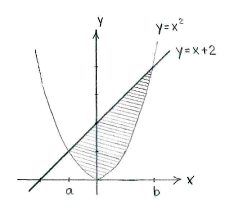Lösung 2.1:4e
Aus Online Mathematik Brückenkurs 2
K (Lösning 2.1:4e moved to Solution 2.1:4e: Robot: moved page) |
|||
| Zeile 1: | Zeile 1: | ||
| - | + | The double inequality means that we look for the area of the region which is bounded above in the y-direction by the straight line | |
| - | < | + | <math>y=x+\text{2}</math> |
| - | + | and from below by the parabola | |
| - | + | <math>y=x^{2}</math>. | |
| - | < | + | |
| - | + | If we sketch the line and the parabola, the region is given by the region shaded in the figure below. | |
| - | + | ||
| - | + | ||
| - | + | ||
[[Image:2_1_4_e.gif|center]] | [[Image:2_1_4_e.gif|center]] | ||
| + | |||
| + | |||
| + | As soon as we have determined the | ||
| + | <math>x</math> | ||
| + | -coordinates of the points of intersection, | ||
| + | <math>x=a</math> | ||
| + | and | ||
| + | <math>x=b</math>, between the line and the parabola, we can calculate the area as the integral of the difference between the curves' | ||
| + | <math>y</math> | ||
| + | -values: | ||
| + | |||
| + | Area= | ||
| + | <math>\int\limits_{a}^{b}{\left( x+2-x^{2} \right)}\,dx</math> | ||
| + | |||
| + | |||
| + | The curves' points of intersection are those points which lie on both curves, i.e. which satisfy both curves' equations: | ||
| + | |||
| + | |||
| + | <math>\left\{ \begin{matrix} | ||
| + | y=x+\text{2} \\ | ||
| + | y=x^{2} \\ | ||
| + | \end{matrix} \right.</math> | ||
| + | |||
| + | |||
| + | By eliminating | ||
| + | <math>y</math>, we obtain an equation for | ||
| + | <math>x</math>, | ||
| + | |||
| + | |||
| + | <math>x^{2}=x+2</math> | ||
| + | |||
| + | |||
| + | If we move all x-terms to the left-hand side, | ||
| + | |||
| + | |||
| + | <math>x^{2}-x=2</math> | ||
| + | |||
| + | |||
| + | and complete the square, we obtain | ||
| + | |||
| + | |||
| + | <math>\begin{align} | ||
| + | & \left( x-\frac{1}{2} \right)^{2}-\left( \frac{1}{2} \right)^{2}=2 \\ | ||
| + | & \left( x-\frac{1}{2} \right)^{2}=\frac{9}{4} \\ | ||
| + | \end{align}</math> | ||
| + | |||
| + | Taking the root then gives that | ||
| + | <math>x=\frac{1}{2}\pm \frac{3}{2}</math>. In other words, | ||
| + | <math>x=-\text{1}</math> | ||
| + | and | ||
| + | <math>x=\text{2}</math>. | ||
| + | |||
| + | The area of the region is now given by | ||
| + | |||
| + | |||
| + | <math>\begin{align} | ||
| + | & \text{Area}=\int\limits_{-1}^{2}{\left( x+2-x^{2} \right)}\,dx=\left[ \frac{x^{2}}{2}+2x-\frac{x^{3}}{3} \right]_{-1}^{2} \\ | ||
| + | & =\frac{2^{2}}{2}+2\centerdot 2-\frac{2^{3}}{3}-\left( \frac{\left( -1 \right)^{2}}{2}+2\centerdot \left( -1 \right)-\frac{\left( -1 \right)^{3}}{3} \right) \\ | ||
| + | & =2+4-\frac{8}{3}-\frac{1}{2}+2-\frac{1}{3} \\ | ||
| + | & =\frac{9}{2} \\ | ||
| + | \end{align}</math> | ||
Version vom 13:05, 18. Okt. 2008
The double inequality means that we look for the area of the region which is bounded above in the y-direction by the straight line \displaystyle y=x+\text{2} and from below by the parabola \displaystyle y=x^{2}.
If we sketch the line and the parabola, the region is given by the region shaded in the figure below.
As soon as we have determined the
\displaystyle x
-coordinates of the points of intersection,
\displaystyle x=a
and
\displaystyle x=b, between the line and the parabola, we can calculate the area as the integral of the difference between the curves'
\displaystyle y
-values:
Area= \displaystyle \int\limits_{a}^{b}{\left( x+2-x^{2} \right)}\,dx
The curves' points of intersection are those points which lie on both curves, i.e. which satisfy both curves' equations:
\displaystyle \left\{ \begin{matrix}
y=x+\text{2} \\
y=x^{2} \\
\end{matrix} \right.
By eliminating
\displaystyle y, we obtain an equation for
\displaystyle x,
\displaystyle x^{2}=x+2
If we move all x-terms to the left-hand side,
\displaystyle x^{2}-x=2
and complete the square, we obtain
\displaystyle \begin{align}
& \left( x-\frac{1}{2} \right)^{2}-\left( \frac{1}{2} \right)^{2}=2 \\
& \left( x-\frac{1}{2} \right)^{2}=\frac{9}{4} \\
\end{align}
Taking the root then gives that \displaystyle x=\frac{1}{2}\pm \frac{3}{2}. In other words, \displaystyle x=-\text{1} and \displaystyle x=\text{2}.
The area of the region is now given by
\displaystyle \begin{align}
& \text{Area}=\int\limits_{-1}^{2}{\left( x+2-x^{2} \right)}\,dx=\left[ \frac{x^{2}}{2}+2x-\frac{x^{3}}{3} \right]_{-1}^{2} \\
& =\frac{2^{2}}{2}+2\centerdot 2-\frac{2^{3}}{3}-\left( \frac{\left( -1 \right)^{2}}{2}+2\centerdot \left( -1 \right)-\frac{\left( -1 \right)^{3}}{3} \right) \\
& =2+4-\frac{8}{3}-\frac{1}{2}+2-\frac{1}{3} \\
& =\frac{9}{2} \\
\end{align}

